
Fall 2022
dear members and friends,
As we head into fall 2022, I am more excited than ever about the museum’s future.
The restoration of NMWA’s building is moving along close to schedule, which feels like a miracle given everything we hear these days about supply chain issues. As you will read on page 20, we are truly rebuilding and reimagining our home from bottom to top as we prepare to reopen just a year from now.
The capital campaign is reaching significant milestones as well, and our dream of meeting the $67.5 million goal feels more attainable than ever, thanks to the support of so many. Now, entering the final year of our project, there is still time to play an important role. Join us in making history and fur thering the legacy of founder Wilhelmina Cole Holladay. For those of you who have contributed to our campaign already, we are proud to include your names on page 24.
Over the summer, the staff has been working diligently on our reopening plans for fall 2023. Beyond the construction checklists, you cannot imagine the myriad details involved in getting NMWA ready to welcome the public into our building once again. Our wonderful teams are working to establish, for example, a new visitor services department, figuring out how best to use our new Education Studio for students of all ages, creating an intriguing new thematic collection installation, planning the first Women, Arts, and Social Change programming, and implementing our firstever digital strategy so that we can continue to stay in touch with all of you.
There is still so much to do, but I am heartened by how much we have accomplished during a very challenging time. Stay tuned for more good news in the coming months, and thank you for your belief in the museum and its mission, which are more important than ever.
with gratitude,
Winton S. Holladay Chair of the Board
MUSEUM INFORMATION 1250 New York Avenue NW Washington, DC 20005
TEMPORARY MAILING ADDRESS 1615 M Street NW, Suite 200 Washington, DC 20036
WEBSITE https://nmwa.org
BROAD STROKES BLOG https://nmwa.org/blog MAIN 202-783-5000 TOLL FREE 800-222-7270 MEMBER SERVICES 866-875-4627; member@nmwa.org SHOP 202-783-7994
LIBRARY AND RESEARCH CENTER 202-783-7365; lrc@nmwa.org MAGAZINE SUBSCRIPTIONS 866-875-4627
SPACE TO SOAR
The museum's building is closed through fall 2023 for a top-to-bottom renovation. For more information, check https://nmwa.org
WOMEN IN THE ARTS Fall 2022 Volume 40, no. 3
Women in the Arts is a publication of the National Museum of Women in the Arts®
DIRECTOR
Susan Fisher Sterling EDITOR


Elizabeth Lynch
PUBLICATIONS ASSISTANT Louisa Potthast DESIGN Studio A, Alexandria, VA
For advertising rates and information, call 202-266-2814 or email elynch@nmwa.org
Women in the Arts is published four times a year as a benefit for museum members by the National Museum of Women in the Arts, 1250 New York Avenue, NW, Washington, D.C. 20005-3970. Copyright © 2022 National Museum of Women in the Arts. National Museum of Women in the Arts®, The Women’s Museum®, #5WomenArtists™, and Women in the Arts® are registered trademarks of the National Museum of Women in the Arts.
On the cover: Eva Gonzalès, Portrait of a Woman in White (detail), 1879; 48 ¼ x 41 in.; Oil on canvas; NMWA, Gift of Wallace and Wilhelmina Holladay; Photo by Lee Stalsworth
Chair’s photo: Courtesy of Winton S. Holladay
WOMEN THROUGH THE ARTS fb.com/womeninthearts @womeninthearts @womeninthearts
CHAMPION
→ 8
Legacy Gifts from the Holladay Collection
The museum has received more than sixty works of art from the collection of Wallace and Wilhelmina Holladay, the culmination of hundreds of gifts from NMWA’s founders over decades.
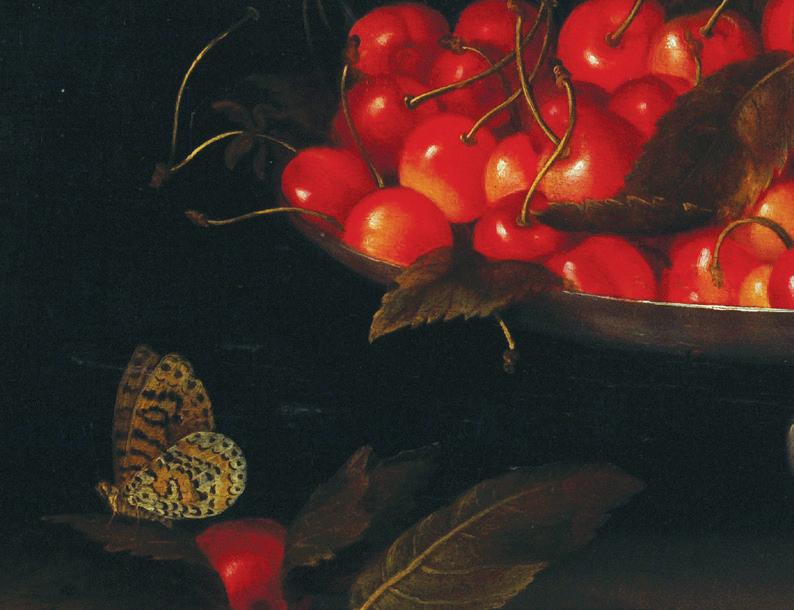
virginia treanor
↓ 16
Lookout: Katharina Cibulka
Austrian artist Katharina Cibulka discusses her new public art installation, soon to be unveiled on construction scaffolding on the museum’s north-facing façade.
hannah shambroom
→ 20
Women on the Renovation Team

The many women working on NMWA’s renovation— in architecture, engineering, design, and construction— are making strides on the project.
winton smoot holladay
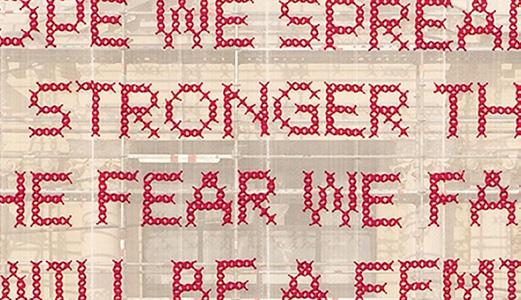
Contents Contents
“Gonzalès’s Portrait of a Woman in White immediately becomes one of the museum’s best examples of nineteenth-century French painting.”
PAGE 8
// FEATURES
// DEPARTMENTS 2 Arts News 4 Culture Watch 6 Education Report 7 Dedicated Donor: Susan Goldberg 12 Calendar 15 On the Blog: Lalla Essaydi 22 Committee and Museum News 24 Supporting Roles 25 Museum Shop
Below, left: Jennifer Bartlett, 1941–2022
A new public art installation at the Los Angeles County + USC Medical Center, Sobrevivir (Survival) by artist Phung Huynh, comprises a courtyard as well as an exhibition. The outdoor work was commissioned to apologize to and honor women harmed by the medical center’s coercive sterilization practices between the 1960s and ’70s, as well as a group of ten Mexican American women who led a class-action lawsuit fighting for better regulations and maternal healthcare. The centerpiece, a twenty-one-foot diameter Cor-ten steel disk, is etched with an image of La Virgen de Guadalupe’s praying hands surrounded by gracefully curving leaves and roses. A seating area features sculptural texts inspired by the bereaved mothers, and an indoor community quilt exhibition provides additional space for viewers to reflect.

In Memoriam
Jennifer Losch Bartlett, an icon of the New York art world, died July 25 at age 81. Bartlett, born in Long Beach, California, in 1941, is known for her serial approach to Minimalist, conceptual works that span painting, printmaking, and sculpture. Innovative in her processes and materials, she created works such as her monu mental Rhapsody (1976), a grid of 987 enamel-covered steel plates. Bartlett’s attempt to create a painting “that had everything in it,” as she said, included thematic sections that documented the everyday human experience. By

combining figurative and abstract images, as well as a variety of mediums, her art was not easily categorized. Throughout her career, Bartlett garnered critical acclaim, and her work is repre sented in NMWA’s collection as well as those of the Metropolitan Museum of Art, the Museum of Modern Art, and many others.
Below,
New U.S. Poet Laureate
Ada Limón will be the nation’s 24th poet laureate, the Library of Congress announced on July 12. She is succeeding Joy Harjo,

who has held the position since 2019. Limón, who is of Mexican ancestry, has published six collections of poetry, including The Carrying (2018), which won the National Book Critics Circle Award for Poetry. Limón believes that poetry plays an important role in connecting people: “I think that it’s really important to remember that even in this particularly hard moment, divided moment, poetry can really help us reclaim our humanity.”
By the Numbers
In August, the BBC released “Recalculating Art,” an audio documentary in which journalist Mary Ann Sieghart explores the art world’s gender value gap. She interviews artist and author Helen Gorrill, whose analysis of 5,000 paintings found that works by men sell for ten times the price of those by women; other guests indicate that collectors and museums are making progress toward more equal representation.
2 FALL 2022
News
Arts
Phung Huynh, Sobrevivir, 2022; Photo courtesy of the L.A. County Department of Arts and Culture
STEVEN LAM
right: New U.S. Poet Laureate Ada Limón
Commemorating Survival
PHOTO BY TAKAAKI MATSUMOTO, COURTESY OF MARIANNE BOESKY GALLERY, NEW YORK AND ASPEN, PAULA COOPER GALLERY, NEW YORK, AND THE JENNIFER BARTLETT 2013 TRUST
LIBRARY OF CONGRESS
5 Questions with Sayaka Suzuki
Throughout 2022, NMWA’s #5WomenArtists social media campaign champions emerging and underrepresented artists. With the help of partner arts organizations around the country, we’re featuring the work and voices of selected artists each month.
THROUGH HER ART , Sayaka Suzuki, nominated by the Visual Arts Center of Richmond, investigates her identity as a Japaneseborn person who married into an American family. She explores what it means to adopt a new country and new ideologies, mending heritages together in a new lexicon.


1. Tell us about your work and practice.
I thought I was just a Japanese living in the United States—
I never thought of myself as an immigrant . . . but I am, and my work is about this discovery. I create works that weave stories of immigrants into digestible experiences for viewers. Stories of discovery, adaptation, and heartache. But my work is not just about immigrants—it’s about all of us.
2. Who or what are your sources of inspiration?

I look at traditional Japanese culture and ritual with my deep
desire to preserve them as an outsider. I am especially fond of the resilient culture of rural Japan that revolves around the phrase “mottainai,” to not be wasteful. I find potential in the ideas of using, reusing, upcycling, and giving things a new unexpected purpose.
I am also inspired by the American people’s history and experiences. Our resilience, potential, and sometimes our careless destructive ways hinder our own existence.
I want to capture and celebrate the mundane narratives that make us wonderfully human.
3. As an artist, what is your most essential tool (besides your hands)?
If empathy can be considered a tool, that is the most important tool in my studio practice. It’s the driving force behind what I make.
4. Where do you obtain your materials?
Heirloom kimono dug up from my parents’ home, porcelain slip from a local ceramic supply store, drywall and wood from hardware stores, rice paper kept from my childhood calligraphy class, and sashiko thread sent by my parents in Japan. I am also a collector—I find inspirational materials walking into the woods, off beaten paths, and in the deep crevices of my childhood home.
5. Who are your favorite #5WomenArtists?
Nina Katchadourian, Judith Schaechter, Chiharu Shiota, Janine Antoni, and Tanya Aguiñiga.

3 WOMEN IN THE ARTS #5WOMENARTISTS
Sayaka Suzuki in her studio; Photo courtesy of the artist
US!
//
JOIN
Champion women through the arts with NMWA membership
ARIZONA
And Let it Remain So: Women of the African Diaspora
Phoenix Art Museum
Through February 12, 2023 https://phxart.org
Works by Widline Cadet, Jasmine Clarke, Hellen Gaudence, Nadiya I. Nacorda, and Sasha Phyars-Burgess explore the influence of the African Diaspora on their understandings of identity and place.
CALIFORNIA
by Alison Knowles: A Retrospective (1960–2022)
BAMPFA, Berkeley
Through February 12, 2023 https://bampfa.org
This exhibition featuring work by Fluxus member Knowles presents her groundbreaking interdisciplinary experiments that have influenced artists for more than fifty years.
WASHINGTON, D.C.
The Double: Identity and Difference in Art since 1900
National Gallery of Art Through October 31, 2022 https://nga.gov
Featuring a work on loan from NMWA’s collection by Harmony Hammond, this exhibition explores how artists employ doubled formats to explore perceptual, conceptual, and psychological themes.
FLORIDA
She/Her/Hers: Women in the Arts of China Harn Museum of Art, Gainesville
Through March 24, 2024 https://harn.ufl.edu
Spanning the seventh century to the present, more than fifty works explore the intersecting roles women have played as pictorial subjects, artists, and consumers in China.
GEORGIA
Monir Farmanfarmaian: A Mirror Garden High Museum of Art, Atlanta November 18, 2022–April 9, 2023 https://high.org
Sculptures, drawings, textiles, and collages by Farmanfarmaian span four decades, including her geometric mirror sculptures that blend hard-edge abstrac tion with motifs from Persian architecture.

MINNESOTA
Pao Houa Her: Paj qaum ntuj / Flowers of the Sky Walker Art Center, Minneapolis Through January 22, 2023 https://walkerart.org
Known for exploring themes of migration, displacement, and ecological resilience, Her debuts a new body of photographs made in Northern California.
MISSOURI
Barbara Chase-Riboud, Monumentale: The Bronzes Pulitzer Arts Foundation, St. Louis September 16, 2022–February 5, 2023 https://pulitzerarts.org
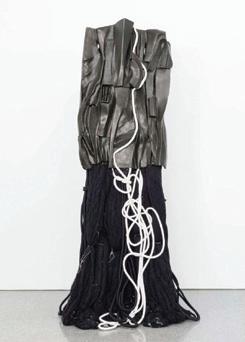
The largest exhibition of Chase-Riboud’s work to date encompasses the artist’s sculpture, works on paper, and poetry, tracing her meditations on monument, form, and memory.
NEW YORK
Doreen Lynette Garner: REVOLTED New Museum, New York City Through October 16, 2022 https://newmuseum.org
Garner’s practice exposes the histories and enduring effects of racial violence in the United States through newly commissioned, visceral works.
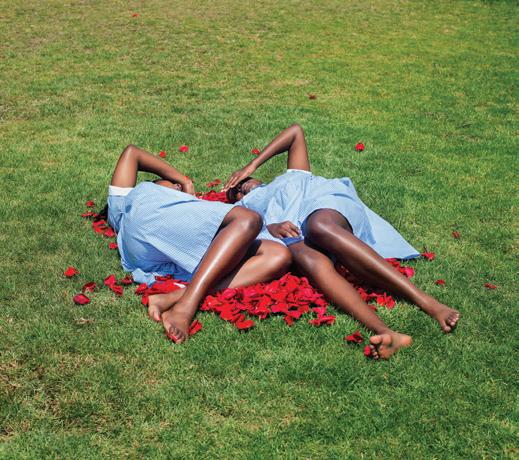
PHOTO BY E.G. SCHEMPF, 2019; © BARBARA CHASE-RIBOUD
ARIZONA // Widline Cadet, Nan Letènite (In Eternity), 2021; Inkjet print; Courtesy of the artist; On view at the Phoenix Art Museum
4 FALL 2022
Culture Watch
// EXHIBITIONS
GEORGIA // Monir Shahroudy Farmanfarmaian, Untitled (Muquarnas), 2012; Mirror, reverse-glass painting, and plaster on wood; High Museum of Art, Purchase with funds from the Farideh & Al Azadi Foundation; On view at the High Museum of Art
© MONIR SHAHROUDY FARMANFARMAIAN
MISSOURI // Barbara Chase-Riboud, Malcolm X #13, 2008; Bronze with black patina, silk, wool, and synthetic fibers with steel support; Kemper Museum of Contemporary Art, Museum purchase made possible by a gift from Bebe and Crosby Kemper Foundation; On view at the Kemper © WIDLINE CADET
TEXAS
SLAY: Artemisia Gentileschi & Kehinde Wiley
Kimbell Art Museum, Fort Worth
Through October 9, 2022 https://kimbellart.org
Two paintings—Artemisia Gentileschi’s and Kehinde Wiley’s renditions of Judith and Holofernes, created 400 years apart—invite visitors to reflect on contemporary and historical issues.
WASHINGTON Indigenous Matrix: Northwest Women Printmakers
Seattle Art Museum
Through December 11, 2022 https://seattleartmuseum.org
Contemporary silkscreen prints by Northwest Native women delve into personal experiences and complex mythologies in bold graphics and striking colors.

International CANADA
Esmaa Mohamoud: To Play in the Face of Certain Defeat
Winnipeg Art Gallery, Manitoba
Through October 16, 2022 https://wag.ca
Mohamoud re-examines social and cultural understandings of contemporary Blackness through sculpture, photography, video, and installation.
Portrait of an Unknown Lady
Like María Gainza’s Optic Nerve (2019), her new novel, Portrait of an Unknown Lady (Catapult, 2022, trans. Thomas Bunstead), follows a woman obsessed by art. Featuring a confession in a sauna and a bohemian forgery ring, this slim, shadowy story conceals more than it reveals. In Buenos Aires, an unnamed narrator called Señorita M. working for an art authenticator comes to learn that her mentor, Enriqueta, has been providing certificates of authenticity to forged works of art. This does nothing to dim her enthusiasm, as Enriqueta has won over her protégée with dynamism and disregard for convention. “Can a forgery not give as much plea sure as an original?” Enriqueta asks. The narrator thinks, “We were two romantics, rebels to the bourgeoisie and to that whole way of seeing the world: the buying way.” Following Enriqueta’s death, the narrator goes in search of the talented forger she knows as Renée, a specialist in forging paintings by the actual historical artist Mariette Lydis. This wry and dreamy novel—peppered with quotations, references, and counterfeit auction catalogue entries—explores elusive questions about what imbues art with life.
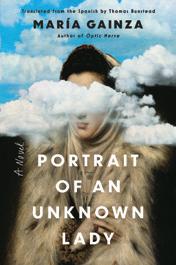
Women Painting Women
Is there a female gaze? Women Painting Women (DelMonico and the Modern Art Museum of Fort Worth, 2022) interro gates this question through the works of forty-six women artists, from the 1960s to the present, who choose women as subject matter. It illustrates how painting is most associated with male interpretations of the female body, and how women have created counterimages: Amy Sherald depicts Black women in gray skin tones to defuse the white gaze; Alice Neel paints unromanticized pregnant women; Tracy Emin paints women bleeding in her “period paintings”; Marilyn Minter paints her subjects with body hair; Mickalene Thomas quotes Manet’s Olympia but puts the Black woman in the spotlight; and Paula Rego destabilizes male-centric culture by bringing together folk culture and fem inism. “It was a real challenge to define oneself and one’s art outside the narrow parameters of the mainstream art world. But we were doing this and it felt good,” Faith Ringgold writes in an essay. Women
Painting Women (along with the exhibition, on view in Fort Worth through September 25) presents a survey of artists who painted outside these narrow parame ters and celebrates the female image in its many forms.
// Louisa Potthast

5 WOMEN IN THE ARTS // BOOKS
// Elizabeth Lynch
WASHINGTON // Francis Dick, Raelene, 1999; Silkscreen print; Seattle Art Museum, Gift of Simon Ottenberg; On view at the Seattle Art Museum
© FRANCIS DICK
Education Report
Food for Thought
In July, the museum’s third annual Virtual Educator Summer Camp served up a tempting menu of eight profes sional development sessions on the theme of food and art. NMWA educators kicked things off with “Feast Your Eyes,” a virtual talk highlighting collection works by twenty-eight women artists, from seventeenth-century still-life painter Fede Galizia to contemporary photographer Graciela Iturbide. Participants— a total of 112 educators (many attending multiple sessions) from six countries, twenty-six states, and Washington, D.C.— declared the food theme fun and accessible. They also shared high praise for the inspiring presentation. Said one, “You cer tainly gave me food for thought for the upcoming school year as far as exploring new works of art or artwork we already visit. Wonderful!”
// Virtual Educator
Summer Camp participant Subsequent sessions welcomed teaching artists and instructors from Maryland, Massachusetts, New York, Virginia, Washington, and Washington, D.C., who intro duced a range of art projects and discussion techniques. Sarah Matthews guided participants through the creation of a Jacob’s Ladder book, which reveals
patterns and panels as if by magic when manipulated. Irene Chan taught a linked petal-fold book and shared how she has transformed this format into wearable art during storytelling performances.
Participants explored simple formats for creating illustrated zines with Robin Ha, author and illustrator of the award-winning Almost American Girl, based on her own immigrant experience, and Cook Korean!: A Comic Book With Recipes, a cookbook graphic novel. “Printmaking Primer” with Kim Van Someren helped educators experiment with basic image-building strategies—pochoir, monotype, and collage—using low-tech, non-toxic techniques.
Founder and Director of JusticexDesign (JxD) Sheya introduced JxD tools, which support learners in perceiving designed injustices and imagining their participation in co-liberation. Later in the month, certified Visual Thinking Strategies (VTS) trainer and gender-queer artist Kris Grey acquainted educators with VTS, a learner-centered facilitation
Clockwise from left: Graciela Iturbide, Cuatro Pescaditos, Juchitan, Oaxaca (Four Little Fish), 1986 (printed later); Gelatin silver print, 18 ¼ x 15 in.; NMWA, Gift of Charles and Teresa Friedlander, in honor of his mother, Jacqueline S. Friedlander

Guest instructor Kim Van Someren shares her print, which features techniques from the session
Sarah Matthews demonstrates a step in creating a Jacob’s Ladder book

method that fosters collaborative, inclusive, community-building dialogue. Both JxD and VTS encourage close looking and deep thinking, which educators valued for their students and themselves. “All the NMWA sessions recently have prompted me to try slow looking,” said one.
Finally, we concluded this summer’s program with a lighthearted, participatory session of “#5WomenArtists Trivia,” which has become a camp tradition.
Extending the food theme, NMWA’s educators and guest instructors each introduced themselves with creative selfportraits, crafted in response to prompts such as “take a picture of your favorite food,” and “craft an enticing title for the story of a personal meal memory.” Many participants shared their own self-portraits, embracing the bite-size activities for their creativity and easy adaptability to the classroom. These ideas, along with session recordings, handouts, and other resources, are available to all attendees in an online “Tool Kit” to support their work with students through out the year.
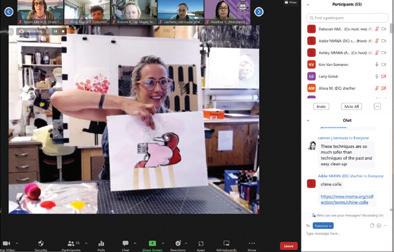
6 FALL 2022
“Thank you for the terrific summer workshop season!
I have a lot to take to the classroom this year that I know the students will engage in and enjoy.”
GRACIELA ITURBIDE
©
Dedicated Donor
// SUSAN GOLDBERG
Goldberg was recently named vice dean and professor of practice at Arizona State University, with dual appoint ments to the Walter Cronkite School of Journalism and Mass Communication and the College of Global Futures. She was previously editor-in-chief of National Geographic and editorial director of National Geographic Partners, where she led journalism across platforms for eight years.
the landscape, you should talk about the environment, climate change, sustainability, and the species extinction crisis. This was a way to really modernize our content, and that’s what I’m really proud of.”
FOR SUSAN GOLDBERG , a lifelong journalist and the new president of NMWA’s Board of Trustees, support for the museum is tied to her passions for storytelling and advancing gender equity. She is glad to be taking on a larger leadership role during the renovation, as the museum prepares to reopen in fall 2023: “I think there is an enormous opportunity for the museum to shout from the rooftops about what it is and what it represents. My mother often said a very old-fashioned thing: you never get a second chance to make a first impression. But this actu ally is a second chance. The wonderful patrons, volunteers, and donors will be so proud of this building, renewed thanks to their help. We will re-engage with them and also reach out to a new generation of people who care about art and equity.”
NMWA Director Susan Fisher Sterling //
When she was starting her career as a young journalist, Goldberg says, “There were not many female reporters or editors, and there were even fewer women running news organizations, which was what I really wanted to do. It always bothered me, but my career, beginning in about 1980, developed on a seam of societal change. I had opportunities to succeed that women just a little older didn’t have. Along the way, I have tried to help the next generation— journalists, photographers, young lawyers, or others—and support equal representation.”

Alongside the increasing attention to gender equity she saw in newsrooms, Goldberg found that technology and social media were rapidly changing the nature of journalism. At National Geographic, “We leaned into the distribution of our content and tried to make that current, and we also changed the kinds of stories we covered. National Geographic has been covering the human journey for 135 years. To cover the human journey in 2022, you should be talking about gender, race, and the journey of women. If you’re going to talk about
Long interested in art and museums, Goldberg was inspired by her first visit to NMWA, in 2012, and joined the board shortly afterward. She got to know museum leaders including NMWA Founder Wilhelmina Cole Holladay. “At the time I joined, Mrs. Holladay was still very active at the museum. Listening to her talk about building the museum from the ground up, what inspired her, and why it was so important was very meaningful.” Goldberg adds, “Mrs. Holladay had an indomitable spirit. One of the things I love about her story is that she didn’t really start working on the museum until she was about sixty. I’m sixty-two, and sometimes I think I’m nearing the end of my career, then I remind myself of all that Mrs. Holladay accomplished beginning when she was in her sixties. It’s a great lesson.”
7 WOMEN IN THE ARTS
COURTESY OF SUSAN GOLDBERG
“We are so pleased to welcome Susan Goldberg as NMWA’s new Board President. She brings a new perspective and wonderful energy to the position, and I share her excitement about our building’s reopening celebrations next year. We can’t wait to welcome everyone to the renewed NMWA!”
Adèle Romany, Portrait of an Artist, Traditionally Identified as Mademoiselle Halbou, ca. 1795; Oil on canvas, 59 ¼ x 46 ¼ in.; NMWA, Gift of Wallace and Wilhelmina Holladay
Legacy Gifts Holladay Col from lec the tion
Virginia Treanor
Following the passing of NMWA Founder Wilhelmina Cole Holladay in March 2021, the museum has received more than sixty artworks from the personal collection that she built with her late husband, Wallace. This gift is the culmination of hundreds of art donations from the Holladays over decades. Beginning with the opening of the museum, when they gave more than four hundred paintings, sculptures, prints, and drawings, the Holladays continuously donated art to the museum over their lifetimes.
Along with their founding vision for NMWA, the art they collected became the bedrock of our institution. NMWA is grateful and proud to welcome these additional works into the museum’s collection, to share them with the public in honor of the Holladays’ legacy.
Our founders’ keen eye and wide-ranging interests are evident in the recent gift: it includes paintings, prints, and sculpture from the early seventeenth through the late twentieth centuries.
PHOTO BY LEE STALSWORTH
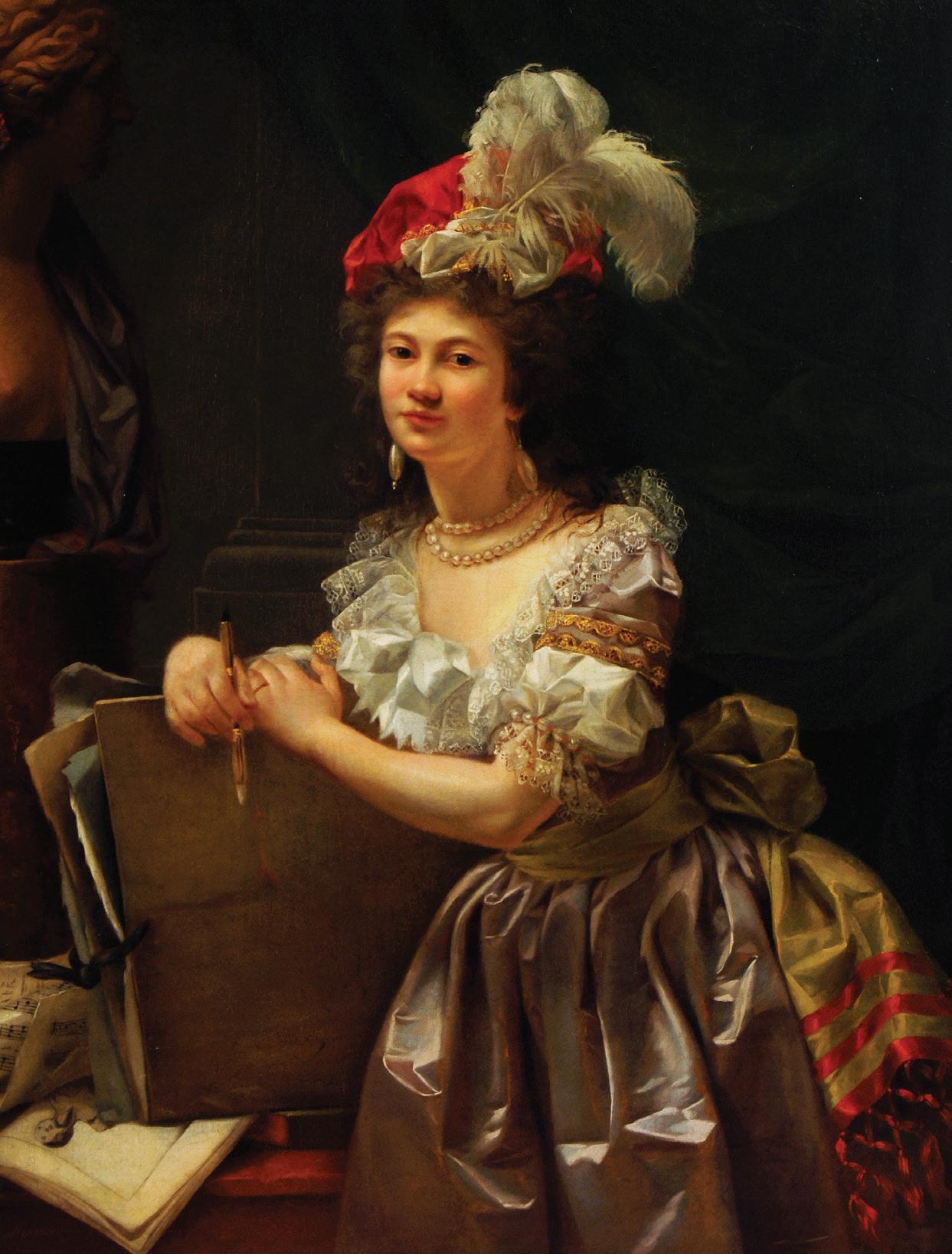
Fede Galizia, Cherries in a silver compote with crabapples on a stone ledge and a fritillary butterfly, ca. 1610; Oil on panel, 19 ¾ x 25 ½ in.; NMWA, Gift of Wallace and Wilhelmina Holladay

Personal Favorites
Early champions of collecting art by women, the Holladays chose works for both their historical importance and the connection they felt with them. The earliest work in this group is a vibrant still-life of a bowl of cherries by Milanese artist Fede Galizia (ca. 1578–ca. 1630). This is the first work by the artist to enter the museum’s collec tion and complements still-lifes by other early modern artists such as Clara Peeters. Also enhancing the collec tion of early still-life paintings are Still Life with Basket of Fruit, a Vase with Carnations, and Shells on a Table (ca. 1650 52) by Giovanna Garzoni (1600–1670) and another lusciously painted basket of fruit from about 1630 by French artist Louise Moillon (1610–1696). This is the first work by Garzoni in the collection and the third by Moillon. French art of the eighteenth and nineteenth centuries was a particular favorite of Wilhelmina Cole Holladay’s, so it is no surprise that this gift includes four paintings, all portraits, from this period: two works by Adèle Romany (1769–1846), one by Louise Rose Julie Duvidal de Montferrier (1797–1865), and one by Impressionist painter Eva Gonzalès (1849–1883).
The two portraits by Romany, both dating to around 1795, are the first works by this artist to enter the collection. A contemporary of Élisabeth Louise Vigée-LeBrun and Anne Vallayer-Coster, Romany was known for her portraiture and exhibited multiple times at the Paris Salon over a span of more than three decades. In Portrait of an Artist, Traditionally Identified as Mademoiselle Halbou (ca. 1795), Romany depicts
a fashionably dressed woman standing at a table on which she rests a large folio with sheets of paper protruding from the edges. Most likely a folder to keep sketches and drawings, it rests atop more papers: visible on one is a human figure, while another is a crumpled sheet of music. Together with the stylus/brush in her right hand and classical bust in the back ground, it appears the sitter is practiced in both the visual and musical arts.
Eva Gonzalès was the only formal student of noted Impressionist artist Édouard Manet. She focused on por traiture and domestic scenes. Gonzalès’s Portrait of a Woman in White (1879; on this issue’s cover) is the first painting by the artist to enter NMWA’s collection, and immediately becomes one of the museum’s best examples of nineteenth-century French painting. Gonzalès’s virtuosity in painting is evident especially in her masterful rendering—all in tones of white—of the satin sheen of the subject’s dress and the delicate frills of lace on her bodice, cuffs, and skirt.
Among the many works from the early twentieth century are a painting by Paula Modersohn-Becker (1876–1907) and no less than two paintings and five works on paper by Gwen John (1876–1939).
Modersohn-Becker was an Expressionist, a movement concerned with communicating emotion through art, and she is known for her stark images of individuals, such as Head of an Old Peasant (ca. 1903), as well as her female nudes. She avoided conventional beauty standards and captured her sitters in thick, impasto paint in a subdued and earthy
10 FALL 2022
PHOTO BY LEE STALSWORTH
palette. Tragically, Modersohn-Becker’s life was cut short at the age of thirty-two; she died, most likely from a blood clot, shortly after giving birth to her first child.
Overshadowed during her lifetime by her brother Augustus John, also an artist, as well as her lover Auguste Rodin, Gwen John is today receiving recognition for her paintings and works on paper that capture the interior quiet of her sitters. John studied painting at the Slade School of Fine Art in London and, later, trained with James McNeill Whistler in Paris at his Académie Carmen. La Petite Modèle (The Little Model) (ca. 1915–20) is characteristic of John’s paint ing style, in which she achieves a dappled effect that makes it appear as though her subjects are mirages that might fade away from view at any moment. Equally diaphanous are her landscapes, such as Red House at Twilight, Meudon, France (ca. 1932), a work in pencil and bodycolor (a thickened watercolor), in which John captures the light of the fading day.
Elizabeth Catlett, Stepping Out , 2000; Bronze, 33 ½ x 8 x 8 ¼ in.; NMWA, Gift of Wallace and Wilhelmina Holladay

Below left: Gwen John, La Petite Modèle (The Little Model), ca. 1915–20; Oil on canvas, 29 ¼ x 26 in.; NMWA, Gift of Wallace and Wilhelmina Holladay

Among the latest-dated works in the Holladays’ gift are two sculptures, one by Elizabeth Catlett (1915–2012) and another by Magdalena Abakanowicz (1930–2017). NMWA has multiple vibrant print works by Catlett, but Stepping Out (2000) is the first sculpture by the artist in the collection. Made of bronze, Catlett’s female figure confidently strides forward, wearing a dress and high-heeled shoes. Catlett, who studied with the artist Grant Wood at the University of Iowa, adopted a more geometrically abstract approach to her forms later in her career, of which this sculpture is an example. Abakanowicz’s sculpture Kayser Infant II (2001) is part of a series of faces on poles she created from the 1980s through the early 2000s, which evoke archaeological arti facts or death masks. This work joins Abakanowicz’s fiber sculpture 4 Seated Figures (2002), already in the collection.
Other highlights include a print and a drawing by Louise Bourgeois (1911–2010); a pastel Flower Study (Étude de fleurs) (ca. 1960) by Sonia Delaunay (1885–1979); three still lifes by Claude Raguet Hirst (1855–1942); and four paintings by Jane Peterson (1876–1965). While this is not a complete list of the works in this extraordinary gift, it represents the broad scope of the Holladays’ collecting practices.
Giving Thanks
We look forward to sharing many of these new additions to the collection upon our reopening and in the coming years. This autumn marks the centenary of the birth of Wilhelmina Cole Holladay, who devoted the later decades of her life to NMWA. Thanks to the Holladays’ foresight and generosity, the world not only has a museum dedicated to showcasing art by women, but a collection that encompasses a large swath of women’s achievements of the past 500 years.
// Virginia Treanor is the associate curator at the National Museum of Women in the Arts.
11 WOMEN IN THE ARTS
PHOTO BY LEE STALSWORTH
© MORA-CATLETT
FAMILY / LICENSED BY VAGA AT ARTISTS RIGHTS SOCIETY (ARS), NEW YORK; PHOTO BY LEE STALSWORTH
Daily/Weekly/Monthly
Lookout: MISS CHELOVE
Extended through September 26, 2022
On-site façade installation.
Lookout: Katharina Cibulka October 28, 2022–February 26, 2023
On-site façade installation.
Collection on the Move:
During the museum’s renovation, visit highlights from the collec tion at the National Gallery of Art and Baltimore Museum of Art and in special exhibitions around the world. Learn more at https://nmwa.org/collection-onthe-move

Online exhibitions: Revisit favorite NMWA exhibitions and more at https:// nmwa.org/whats-on/exhibitions/online.
F Free
M Free for members
R Reservations required at https://nmwa.org
O No reservations required
E Exhibition-related program
V Virtual/online program (Please note that the time zone for all online programs is Eastern Time)
Live transcriptions are provided during most virtual programs. To request additional access services, please check the online calendar for contact information. Two weeks’ notice is appreciated but not required.
During the museum’s top-to-bottom building renovation, programs take place online unless otherwise noted. Join us for Art Chats, Happy Hours, Fresh Talks, and more.
Art Chats @ Five
MOST FRIDAYS 5–5:45 P.M. // F M R E V
Jump-start your weekend with art! Join NMWA educators for informal 45-minute art chats about selected artworks from NMWA’s collection and exhibitions.
The Tea
FIRST FRIDAYS 12–1 P.M. // F M O V
Women musicians perform original work via livestream, followed by a short interview over a cup of tea.
NMWA xChange
SECOND TUESDAYS 12–12:45 P.M. // F M R E V
Join NMWA educators, curators, and special guests as they talk about art and its intersections with timely social topics and issues.
September
9/13 NMWA xChange: Women Building Better
TUE 12–12:45 P.M. // F M R V
In this episode, conservator Wendy Jessup and architects Cara Versace and Sandra Vicchio discuss their involvement with NMWA’s renovation.
9/14 Virtual Happy Hour: Misattributions in the Art World
WED 5:30–6:30 P.M. // F M R V
Where are all the great women artists in the history books? One reason for their absence is that art by many historical women was misattributed to male artists. Learn about famous works that were long thought to be by men but were really created by women artists.
9/16 Art Chat @ Five
FRI 5–5:45 P.M. // F M R V
9/23 Art Chat @ Five
FRI 5–5:45 P.M. // F M R V
9/25 Fresh Talk: Beyond the Wall—Women Muralists
SUN 4:30–6 P.M. // R E
In addition to their visual beauty, murals and graffiti art have the power to highlight issues of social change. Join us for a conversation with muralist MISS CHELOVE, mixed-media artist Nekisha Durrett, and graffiti artist Lady Pink. In-person program at Eaton D.C. $25 general admission, $20 for members, students, and seniors.
Left: MISS CHELOVE, Reseeded: A Forest Floor Flow (installation view), 2022; Printed mesh, 60 x 48 ft.; Commissioned by the National Museum of Women in the Arts with support provided by the DC Commission on the Arts and Humanities
12 FALL 2022 Calendar // EXHIBITIONS
// KEY
© 2022 MISS CHELOVE;
PHOTO BY KEVIN ALLEN
Visit
Attendees enjoy a past MakeHER summit; register for this year’s events on September 25 and 26
Below: Like Water appears in The Tea on October 7
9/26 MakeHER Summit Workshops
MON 10 A.M.–5 P.M. // R
Designed for creative women entrepreneurs at all levels, this intensive day of in-person workshops focuses on setting and achieving goals. In-person program at Eaton D.C. $15 general admission, $10 for members, students, and seniors.

9/28
Cultural Capital: A Celebration of Black Girls’ Childhood

WED 6–7:30 P.M. // F M R V
Join us for a celebration of the joys of Black girlhood in partnership with the Georgetown Law Center on Poverty and Inequality’s Initiative on Gender Justice and Opportunity. In recognition of the center’s tenth anniversary, enjoy an evening uplifting Black girls’ voices.
9/30 Art Chat @ Five
FRI 5–5:45 P.M. // F M R V
October
10/7 The Tea: Like Water
FRI 12–1 P.M. // F M O V
Seamlessly blending electronic and acoustic instruments with transcendent vocals, Like Water layers unique sounds while looping them on the spot.
10/7 Art Chat @ Five
FRI 5–5:45 P.M. // F M R V
10/11 NMWA xChange: Past, Present, Future—Dianne Smith
TUE 12–12:45 P.M. // F M R V
In this episode, artist Dianne Smith discusses her provoc ative and meaningful imagery that challenges viewers to consider pure color, movement, and organic shapes.
13 WOMEN IN THE ARTS
https://nmwa.org for reservations, a complete
calendar of events, and more information.
PHOTO BY KEVIN ALLEN
COURTESY OF LIKE WATER
F Free
M Free for members
R Reservations required at https://nmwa.org
O No reservations required
10
10
FRI 5–5:45 P.M. // F M R V
E Exhibition-related program
V Virtual/online program (Please note that the time zone for all online programs is Eastern Time)
November
11/4 The Tea: Sofar Sounds
FRI 8–10 P.M. // F M R
The special evening event in partnership with Sofar Sounds will be held at Mason Exhibitions Arlington. $25 general admission.
11/4 Art Chat @ Five
FRI 5–5:45 P.M. // F M R V
11/8 NMWA xChange: Girl Power—Gallerist Myrtis Bedolla
TUE 12–12:45 P.M. // F M R V
In this episode, NMWA educators chat with Myrtis Bedolla, the owner and founding director of Galerie Myrtis, a gallery and art advisory with a focus on twentieth- and twenty-first-century art by African American artists.
11/11 Art Chat @ Five
FRI 5–5:45 P.M. // F M R V
11/18 Art Chat @ Five
FRI 5–5:45 P.M. // F M R V
December
12/2 The Tea: B-FLY
FRI 12–1 P.M. // F M O V
12/2 Art Chat @ Five
FRI 5–5:45 P.M. // F M R V
12/8 NMWA Book Club: Finding La Negrita
THU 5:30–7:30 P.M. // F M R V
Join in to explore art, gender, and social change in the contemporary art world and beyond through a book discussion on Finding La Negrita (2022), by Natasha Gordon-Chipembere.

12/9 Art Chat @ Five
FRI 5–5:45 P.M. // F M R V
12/16 Art Chat @ Five
FRI 5–5:45 P.M. // F M R V
FRI 5–5:45 P.M. // F M R V
10/23 Fresh Talk: Art and the Ecstatic
SUN 4:30–6 P.M. // F M R V
For thousands of years, humans have created art expressing their thoughts on creation, spirituality, and the divine. What does it mean for women to document creation and divinity? Join us for a live-streamed conversation featuring artists discussing their work documenting the divine.
10
FRI 5–5:45 P.M. // F M R V
// Education programming is made possible by the A. James & Alice B. Clark Foundation, with additional support provided by the Leo Rosner Foundation, Share Fund, and the William Randolph Hearst Foundation. Additional funding is provided by the Harriet E. McNamee Youth Education Fund and William and Christine Leahy.
The Women, Arts, and Social Change public programs initiative is made possible through leadership gifts from Denise Littlefield Sobel, the Davis/Dauray Family Fund, the Revada Foundation of the Logan Family, and the Susan and Jim Swartz Public Programs Fund
14 FALL 2022 // KEY
/14 Art Chat @ Five
/21 Art Chat @ Five
/28 Art Chat @ Five
© DIANNE SMITH
Dianne Smith, Another Sunday Outing, from the series “Between Harlem and Me,” 2021; Archival digital pigment print, 20 x 20 in.; NMWA, Gift of the artist; Join us for an episode of NMWA xChange featuring the artist on October 11
Five Fast Facts on Lalla Essaydi
// Ashley W. Harris
The museum’s Broad Strokes blog features news about women in the art world, NMWA’s collection and exhibitions, and initiatives like #5WomenArtists. A popular series is “Five Fast Facts,” in which staff members, usually museum educators, highlight facts behind works of art in NMWA’s collection, such as Bullets Revisited #3, by Lalla Essaydi.
Impress your friends with five fast facts about Lalla Essaydi (b. 1965) and her series Bullets and Bullets Revisited (2009–2014).
1. Artful Response
Moroccan-born Essaydi watched the Arab Spring unfold from the United States. Moved to create, she embarked on a series of photographs. “Bullets is about that violence projected on women, specifically physical violence during gatherings in the squares. . . . I was not there. . . . The only thing I could do is
put it in my work and show the world what women were subjected to,” the artist said.¹
2. Setting the Scene
To create the silver-and-goldencrusted elements in works such as Bullets Revisited #3, Essaydi and her assistants gather buckets of assorted bullet casings from shooting ranges in the U.S. Then, they sort the .22 caliber shells; use specialized machines to cut, bore, and polish them; and weave them together with wire.²
3. Model Behavior
At the center of the glittering scene in Bullets Revisited #3 is a model whose skin and dress are covered in henna, which Essaydi applies using a syringe. The artist often works with family acquaintances, and they discuss, agree on, and rehearse all aspects of the image before the shoot. The multi-hour process—eased by music and storytelling—requires patience and stillness from Essaydi’s collaborators.
Essaydi’s work evokes the odalisque but subverts the voyeuristic tradition.
4. Blurred Lines
Essaydi’s script combines the traditionally male art of calligraphy—which she taught herself—and the traditionally female art of henna painting. As she writes, Essaydi draws from her model’s experiences as well as her own, though the intentionally illegible final product keeps the details private.
5. Bigger Picture
Essaydi admires nineteenthcentury Orientalist paintings for their beauty—but not their false narratives. To challenge these representations, she identified three main themes, “the harem, the veil, and the odalisque,” and adopted them throughout her work.³ Bullets Revisited #3 evokes the odalis que—a seductive female nude— but subverts the voyeuristic
tradition with the segmented body and returned gaze.
// Ashley W. Harris is the associate educator at the National Museum of Women in the Arts.
Notes:
1 Virginie Kippelen, “A Conversation with Lalla Essaydi about ‘Bullets,’ the Arab Spring and violence against women,” ArtsATL, February 17, 2017, https://www.artsatl.org/conversationlalla-essaydi-bullets-arab-springviolence-women
2 Hunter Museum of American Art, “Art Wise: Lalla Essaydi,” in conversation with Nandini Makrandi, September 30, 2021, https://www. youtube.com/watch?v=9xCSct7qgI0
3 KPBS Public Media, “San Diego Museum of Art Exhibition Explores Issues Surrounding Role of Women in Arab Culture,” March 27, 2015, https://www.youtube.com/ watch?v=Hvvj20ShAPo
Lalla Essaydi, Bullets Revisited #3, 2012; Three chromogenic prints mounted on aluminum, 66 x 150 in. overall; NMWA, Purchased with funds provided by Jacqueline Badger Mars, Sunny Scully Alsup and William Alsup, Mr. Sharad Tak and Mrs. Mahinder Tak, Marcia and Frank Carlucci, and Nancy Nelson Stevenson

15 WOMEN IN THE ARTS
// ON THE BLOG
© LALLA ESSAYDI; IMAGE COURTESY OF THE ARTIST, MILLER YEZERSKI GALLERY, BOSTON, AND EDWYNN HOUK GALLERY, NYC

Katharına Cıbulka
October 28, 2022 – February 26, 2023
As the museum’s renovation progresses, Austrian artist Katharina Cibulka will cover NMWA’s north-facing façade in one of her monumental “SOLANGE” (German for “as long as”) works. For this series, Cibulka and her team create installations on fabric covering construction site scaffolding. She hand-stitches poetic and witty feminist statements such as “As long as the art market is a boys’ club, I will be a feminist,” “As long as he makes the cash while I work for change, I will be a feminist,” and “As long as women’s power is an underrated energy source, I will be a feminist.” NMWA’s site-specific phrase, conceived with input from the museum’s members, patrons, and neighbors, will be revealed when the work is installed as part of Lookout, a series of commanding outdoor installations during the renovation.
ARTWORK © KATHARINA CIBULKA; PHOTO BY IN THE HEADROOM
LOOK OUT LOOKOUT
Katharina Cibulka installs a “SOLANGE” work
Hannah Shambroom
nmwa exhibition coordinator Hannah Shambroom spoke with Katharina Cibulka about her process for creating these large-scale works, and her excitement about the collabora tion with NMWA—her first installation in the United States.
Hannah Shambroom: What is your artistic background, and how has it prepared you for the work you do now?
Katharina Cibulka: My professional background is in film. I’ve always been interested in people and their personal his tories and stories. I like to listen, ask questions, to explore the energy that lies behind what people say. I love to dive deep into their stories and their impact on the world. I was lucky to learn from some of the best Austrian documentary filmmakers, to accompany them and gain lots of experience.
At 29, I began studying art and digital media, performance art, and visual art narratives at the Academy of Fine Arts Vienna and the School for Artistic Photography Vienna. It was such a privilege to study these subjects. Suddenly I was able to reflect everything I had learned, experienced, and seen from a new perspective, to recontextualize it. And it allowed me to incorporate everything I had done into my artistic work.
HS: How did you transition from video-based work to the much more manual, handwork process of stitching your “SOLANGE” nets?
KC: I’ve been working conceptually for years. I choose the technique and means of expression that I feel best fits the topic or idea. Since my background is in film, it used to be my go-to choice to express my message. With time, my approach became more and more unconventional.
In my work, I am particularly interested in pointing out injustices. I like to hit a nerve, and I like to tell stories that touch people’s hearts. It is my aim to reach as many people as possible instead of staying in my own bubble. How can bigger change happen if I only speak to those who share my opinions or goals? Film can be a heavy medium; so much time, energy, and effort go into it. I’m interested in finding a more concise way to express my ideas. How can we convey a message in a single sentence? How can I get people to start reflecting and discussing what they see? How and where can I reach the most people?
“SOLANGE” is not only about pointing out gender injustice and inequalities, it is also about taking up (a lot of) public space. It is my aim to use the historical practice of embroi dery—traditionally done by women in a private sphere—to claim highly visible places in public; to speak up and say: we’re here, in the male-dominated space of construction sites. Playing with traditional roles and materials is what makes the project so appealing to me.
HS: The creation of each “SOLANGE” work begins long before the completed phrase is installed on scaffolding. Could you describe the process?
KC: Finding the right construction site is the most time-con suming part of the process. We need courageous and visionary partners who share our dream of an equal, fair future, and who are ready to stand up for it.
Once we’ve found a site, I work with my studio team to explore issues that are important to the communities that
Katharina Cibulka, SOLANGE #4 (installation view, Schillerplatz, Vienna, Austria), 2018; Scaffolding net, tulle, and cable ties, 46 x 55 ½ ft.; Image courtesy of the artist

18 FALL 2022
© KATHARINA CIBULKA;
PHOTO BY BERND HOFBAUER
Katharina Cibulka, SOLANGE #14 (installation view, Vienna, Austria), 2020; Scaffolding net, tulle, and cable ties, 46 x 46 ft.; Image courtesy of the artist

live, work, and move around it. We conduct surveys and inter views and learn as much as possible about the culture and history of each place. It is a long process that is crucial; the project is not about projecting our own opinions onto others.
We receive lots of input from community members. We explore their energy, twist and turn their ideas, add puns or ambiguities, strip away negative phrasing, and so forth. It is an equally fun and demanding part of the process that we are immersed in for weeks. It’s like a ping pong game of words and phrases, and at some point, a sentence we want to see in big pink letters emerges.
I visualize the sentence and plot the stitching tem plate, which varies and depends on the size of the nets. The final step is the installation and the big reveal. The phrase remains a secret until this point; no one outside the team and cooperative partners knows the themes we discussed or the sentence we created.
HS: What are some of the challenges you’ve faced while working on construction sites? Have there been any unexpected joys to working in these spaces?
KC: There are usually a lot of challenges in store for us. After all, we work on construction sites in the building industry, which is very much male-dominated. We insert ourselves into this sphere and suddenly work on equal footing with the guys. This requires a lot of open communication and discussion, a lot of back and forth, a lot of asserting ourselves, and also a lot of compromise.
The greatest joy is definitely when we mount and reveal a new net. It feels like a miracle every time! People stand before it in amazement. It is truly uplifting to see a huge, hand-embroidered feminist phrase in public space. To hear people discuss the phrase and its implications, to observe different opinions come apart and then together again— that’s the reward. It is our mission to raise awareness and draw attention to injustices.
HS: Your work at NMWA will be the first “SOLANGE” piece in the United States. What does it mean to you to be working in Washington, D.C., and with NMWA?
KC: What can I say? It is a tremendous gift. When NMWA contacted me and asked if I would be interested in creating a “SOLANGE” net at the museum, two blocks away from the White House and for this exceptional museum, I could hardly believe my eyes. What an offer! Have we already come this far? Just two blocks away from the center of power, where one of the many keys to equality might lie? I love that idea! It’s a beautiful vision. And yes, where there’s power, there’s room for action.
HS: In soliciting input for “SOLANGE,” you ask partici pants, “How long will you be a feminist?” What is your own answer to this question? What is your personal “SOLANGE” phrase?
KC: Oh, it changes all the time! We have an archive of around 10,000 “SOLANGE” phrases. If I had to draft a sentence for myself at this moment, it would be about peace, about women who want control over their own bodies. Or how these bodies are objectified. Or about equal opportunities. There are so many topics that need our attention. And there are so many construction sites all around the world. We are ready to create as many “SOLANGE” nets as it takes and are happy to collaborate all over the globe. Come join us in spreading equality!
// Hannah Shambroom is the exhibition coordinator at the National Museum of Women in the Arts.
NMWA’s site-specific “SOLANGE” phrase will be unveiled in late October. Follow along @WomenInTheArts and @solange_theproject.
19 WOMEN IN THE ARTS
© KATHARINA CIBULKA
Women on the Renovation Team
Winton Smoot Holladay
NMWA was founded to celebrate underrecognized women artists, so we also pay attention to gender disparities in other fields. In choosing the architects, engineers, and others to lead our renovation project, we selected a group of experienced partners—many of them women—across these stereotypically maledominated professions.
Three central members of the team will be featured in an online program on September 13, “NMWA xChange: Women Building Better.” In this episode of the museum’s online talk show, conservator Wendy Jessup and architects Cara Versace and Sandra Vicchio will discuss their work on the renovation project. See this issue’s program calendar on
page 12 for more information, and watch the conversation on YouTube if you are not able to see it live.
Women in the Field
Unfortunately, research indicates that architecture and construction, like many fields, have a long way to go to reach gender equity:
A 2021 study by the Pew Research Center on diversity in STEM fields found that women are especially underrep resented in architecture and engineering. They also found that across all racial and ethnic groups, women in these fields earn significantly less than their male counterparts.
– According to the American Institute of Architects, women’s representation in the profession has made progress in recent decades. However, although nearly half of architecture

20 KEVIN ALLEN PHOTOGRAPHY FALL 2022
students are women, they comprise only 17 percent of registered architects today; representation is worst at the highest levels of management and ownership of firms.
We are proud to entrust the renovation of our landmark building to talented women from our project partners. Not only are they leaders in their fields, they are also examples to young people building their own careers.
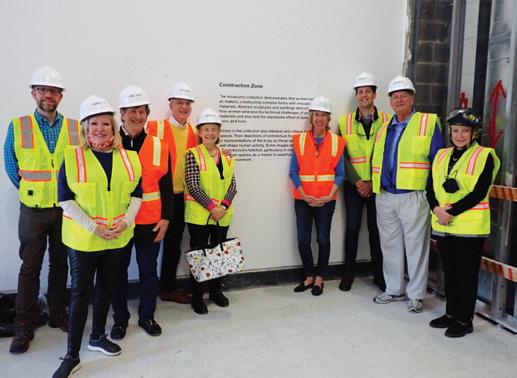
Summer Progress
These women, along with the whole team, have been making great strides in the museum’s renovation work. NMWA’s project involves every part of the building—from the top, where the team is preserving historic details such as the cornice, to the basement, where crews recently finished laying the floors and rails for state-of-the-art collections storage spaces. Their work continued during the summer months:
Crews are working steadily on mechanical, electrical, and plumbing systems that will improve our building’s energy efficiency and versatility. Meanwhile, they have care fully protected all the wonderful historic architectural details throughout the space.
Outside, the ramp is now complete for a new entrance at the building’s northwest corner. This will provide an additional accessible path to our new elevators and allow us to hold programs on the museum’s upper floors during events in the Great Hall.
The museum’s building stands as a beacon and flagship for our mission. When we reopen in fall 2023, visitors will find newly renovated public spaces with more art on view, improved amenities that enhance wayfinding and accessibility, and updated infrastructure that preserves our iconic spaces and helps us care for our unique collections. NMWA will never stop championing women in the arts, and this ambitious project gives us the best opportunity to amplify their voices for decades to come. Our “Space to Soar” capital campaign supports this comprehensive building
restoration. Donors and friends have made extraor dinary gifts at all levels to support this transformative project. Please make your gift today to help us reach our $67.5 million goal. We look forward to celebrating together as we reopen our 1908 historic building next year.
We thank the extraordinary friends of the museum who have made gifts and pledges to support our “Space to Soar” campaign. Visit https://nmwa.org to learn more about this historic project; to make your gift, contact Angie Clexton at aclexton@nmwa.org
–
On the museum’s fourth floor, a section of the floor has been removed, reinforced, and rebuilt to support the weight of library and archival collection materials. Through our
partnership with EarthCam, we have captured time-lapse footage of this exciting change that you can see online.
Looking Ahead
This autumn, as construction continues, we are thrilled to once again activate the building’s exterior with art. The second public artwork on our scaffolding features work by Austrian artist Katharina Cibulka. Her cross-stitched texts, at monumental scale, spell out poetic, pithy phrases that encourage reflection on gender equity. She hand-embroiders these texts using vivid pink tulle, in contrast to the hardedged industrial materials of a construction site.
Through inspiring projects like Cibulka’s installation, NMWA continues to champion women artists even while the building is closed. We look forward to sharing her work, a reminder that women belong in construction, art museums, and everywhere else.
21 WOMEN IN THE ARTS
SPACE
SOAR
NMWA’s landmark 1908 building will reopen in fall 2023 after a major $67.5 million renovation.
//
TO
PHOTO BY JENNIFER TANTUM, JM ZELL PARTNERS
Opposite: NMWA Director Susan Fisher Sterling (center) with many of the women on the renovation project team in the museum’s Performance Hall under construction
// Winton Smoot Holladay is the Chair of the Board of the National Museum of Women in the Arts.
NMWA Director of Operations Gordon Umbarger (left) leads a hard-hat tour of the building with Trustee Martha Dippell, Daniel Korengold, George White, Trustee Patti White, Chair of the Board Winton Holladay, Addison Holladay, Hap Holladay, and Linda Rabbitt
Committee News
A New World—Women to Watch 2024 opens in Kansas City, Missouri Committees are beginning to prepare for the next Women to Watch exhibition at NMWA, which will be held in 2024. The Greater Kansas City Area Committee, now celebrating its twentieth year, welcomed members of the community to the opening of their regional Women to Watch 2024 exhibition at the Kemper Museum of Contemporary Art.
The exhibition, organized by Kemper curatorial director Erin Dziedzic, features five artists whom Dziedzic nominated for Women to Watch 2024: Mona Cliff/HanukGahNé (Spotted Cloud), Bianca Fields, Bev Gegen, Melanie Johnson, and
Sun Young Park. Visit the show at the Kemper through October 16, 2022, or view the digital exhibition guide at https://www. kemperart.org/women-watchdigital-exhibition-guide.
News from Past Women to Watch
Oasa DuVerney, who repre sented New York in Paper Routes—Women to Watch 2020 opened her first solo exhibition, A World to Live In, at Brooklyn’s Welancora Gallery on June 4. The New York Times reviewed the show, describing the signifi cance of the artist’s “Black Power Waves”—which were featured in Paper Routes at NMWA—as “a visual metaphor for communitybased, collective Black political and social power, conceived as a force of nature.”
Left, top to bottom: Artist Bianca Fields with her work at the Greater Kansas City Area Committee’s Women to Watch opening at the Kemper Museum of Contemporary Art
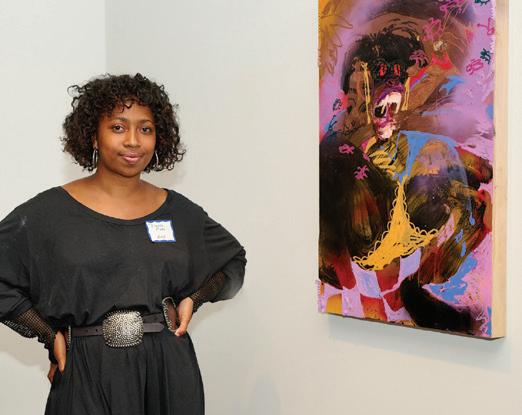
Greater Kansas City Area Committee members Jan Leonard (Co-chair), Dolores Hyde, Arlene Finney (Women to Watch Chair), and Chris LeBeau (Chair) at the group’s exhibition

Capítulo Chileno
Launches
Conversation Series
The Chile Committee of NMWA held a conversation with renowned writer Carla Guelfenbein, whose novel Contigo en la distancia (In The Distance With You) won Latin America’s Alfaguara Prize, an esteemed literary award, along with lawyer, editor, and committee advisory member María Paz Garafulic. This event inaugurated the committee’s “EncontrArte” (“Find Art”) series, which amplifies distinguished women across creative fields.
Through the generosity of San Francisco Advocacy for NMWA and member Fred Levin, NMWA recently welcomed collection acquisitions by three Women to Watch participants from Northern California: Julia Goodman (Paper Routes in 2020), and Katherine Vetne and Davina Semo (Heavy Metal in 2018).

22
PHOTO BY KENNY JOHNSON
PHOTO BY KENNY JOHNSON
FALL 2022 María Paz Garafulic and Carla Guelfenbein converse at the Chile Committee’s first EncontrArte program
PHOTO COURTESY OF EL CAPÍTULO CHILENO DE NMWA
Josephine Lawrence Stribling
Josephine “Jo” Lawrence Stribling, founding member of the Texas State Committee of NMWA, celebrated her 100th birthday with family and friends on January 2, 2022, in San Antonio.

Stribling was born in 1922 in Sam Fordyce, Texas. In her first decade of life, Mary Cassatt was living in Paris; Warren G. Harding was President of the U.S.; King George V ruled over the United Kingdom. In subsequent decades, artists developed new movements, such as Surrealism, modernism, and Abstract Expressionism—and
Frida Kahlo, Georgia O’Keeffe, Louise Bourgeois, and Alma Woodsey Thomas opened gateways for women to shape these movements.
Inspired by these pioneers of art, Stribling gathered women in her own life to participate in her “ranch art camp”—a salon, Texasstyle. In her seventh decade of life, Stribling befriended Wilhelmina Cole Holladay and became a founding member of NMWA and its Texas Committee. Through the turn of the century, both “Billie” and Jo inspired social and cultural change.
Museum News
Become a Docent!
In advance of reopening, NMWA is recruiting a new docent class. The museum’s Docent Corps is a team of talented and dedicated individuals who facilitate high-quality, interactive, visitor-centered collection and exhibition experiences for adult groups. To learn more and

apply, visit NMWA’s Volunteer Opportunities page at https://nmwa.org/work-with-us/ volunteer. Apply before September 30.
Prepare
for Year-End Giving
With the end of 2022 approach ing and NMWA’s annual Matching Gift Challenge right around the
NMWA extends wishes for a very happy centenary to Stribling: artist, pilot, rancher, philanthropist, and mother of four. In the words of one of her proud sons, Dr. Johnny Clay
Johnson, “Her youthful aspirations became her life goals and accomplishments: to live by water, to fly, to be an artist, to see the world, to love and be loved.”
corner, please remember the many advantageous ways to make a year-end gift to NMWA.
– Donating appreciated stocks, bonds, or mutual funds is quick and simple and may provide you with significant tax benefits.
– If you are 70 ½ or older, you can make cash gifts totaling up to $100,000 from your tra ditional or Roth IRA to NMWA.
– Contribute through a donor advised fund (DAF), which can be established with entities including community founda tions and financial services companies.
Many companies offer a matching gift program to current employees and retirees that could double— or even triple—your generous contribution to NMWA.
Visit https://nmwa.org/yearend for more information.
Practice Artful Holiday Giving and Support Women in the Arts
Help women in the arts gain new champions by sharing the gift of NMWA membership. Membership includes:
A welcome packet with membership card(s) and the current issue of Women in the Arts magazine, A subscription to quarterly Women in the Arts magazine and monthly e-news, Discounts in our online Museum Shop,
– Invitations to virtual programs (email required), and Reciprocal benefits to outstanding museums nationwide at the Friend level and higher.
To ensure timely delivery for the holidays, please order no later than December 1 at https://nmwa.org/holidaygift or by calling 866-875-4627.
23 WOMEN IN THE ARTS
// CELEBRATING ONE HUNDRED YEARS
PHOTO BY HAROLD LYNN ADAMS
Museum visitors enjoy a tour led by a NMWA docent, discussing Jaune Quick-toSee Smith’s Indian, Indio, Indigenous (1992) and other works
KEVIN ALLEN PHOTOGRAPHY
Jo Stribling (seated, center) with members of the Texas State Committee of NMWA on her 100th birthday
Supporting Roles
BOARD OF TRUSTEES
Winton S. Holladay—Chair of the Board, Susan Goldberg—President, Sheila Shaffer—Treasurer and Finance Chair, Charlotte Buxton—Secretary, Nancy Duber—Governance Chair, Susan Fisher Sterling—Alice West Director**, Pamela Parizek—Audit Chair, Marcia Myers
Carlucci—Building Chair, Amy Weiss— Communications Chair, Ashley Davis— Government Relations Chair, Nancy Nelson Stevenson—Works of Art Chair, Diane Casey-Landry—Investment Chair, Gina Adams, Janice Adams, Lizette Corro, Deborah Dingell, Martha Dippell, Susan Dunlevy, Anjali Gupta, Pamela Gwaltney, Bonnie McElveen Hunter, Cindy Jones, Sally Jones, Ann Walker Marchant, Jacqueline Mars, Marlene Malek, Juliana May, Lucretia Adymy Risoleo, Stephanie Sale, Julie Sapone, Karen Sonneborn, Kathleen Elizabeth Springhorn, Jessica Sterchi, Mahinder Tak, Sarah Treco, Annie Totah, Alice West, Patti White
** Ex-Officio
NMWA ADVISORY BOARD
Sarah Bucknell Treco—Chair, Noreen Ackerman, Kathe Hicks Albrecht, Sunny Scully Alsup, Jo Ann Barefoot, Gail Bassin, Arlene Begelman, Sue Ann Berlin, Catherine Little Bert, Brenda Bertholf, Margaret C. Boyce Brown, Deborah G. Carstens, Rebecca Chang, Paul T. Clark, Amb. Maria Eugenia Chiozza, Barbara Cohen, Marcella Cohen, Marian Cohen, Donna Paolino Coia, Robyn D. Collins, Linda Comstock, Margaret Conklin, Elizabeth Crane, Lynn Finesilver Crystal, Elizabeth Cullen, Mary Lou Dauray, Verónica de Ferrero, Belinda de Gaudemar, Kitty de Isola, Katy Graham Debost, Alexis Deutsch, Ellen Drew, Kenneth P. Dutter, Christine Edwards, Anne N. Edwards, Gerry Ehrlich, Elva Ferrari-Graham, Lisa Claudy Fleischman, Rosemarie C. Forsythe, Anita Friedt, Claudia Fritsche, Barbara S. Goldfarb, Sally Gries, Michelle Guillermin, Anjali Gupta, Pamela Gwaltney, Jolynda Halinski, Florencia Helbling, Sue J. Henry, Imogene Jensen, Jan Jessup, Alice Kaplan, Paulette Kessler, Arlene Fine Klepper, Doris Kloster, Carol Kolsky, Robin Rosa Laub, Elizabeth Leach , Cynthia Madden Leitner, Gladys Lisanby, Sarah H. Lisanby, M.D., Fred M. Levin, Bonnie Loeb, Gloria and Dan Logan, Angela M. LoRé, Clara M. Lovett, Joanne Ludovici, Marcia MacArthur, Patricia Macintyre, Linda Mann, Maria Teresa Martínez, C. Raymond Marvin, Ellen Stirn Mavec, Dee Ann McIntyre, Cynthia McKee, Constance C. McPhee, Lorna Meyer Calas, Anu Mitra, Milica Mitrovich,
Mary V. Mochary, Claudia Pensotti Mosca, Deborah E. Myers, Jeannette T. Nichols, Kay Woodward Olson, Nancy Olson, Monica T. O’Neill, Katherine D. Ortega, Carol Parker, Anthony Podesta, Sarah (Patti) Pyle, Lucy Rhame, Helena Ribe, Barbara Richter, Elizabeth Robinson, Tara Rudman, Elizabeth A. Sackler, Stephanie Sale, Consuelo Salinas de Pareja, Abby Sadin Schnair, Steven Scott, Kathy Sierra, Ann Simon, Geri Skirkanich, Dot Snyder, Denise Littlefield Sobel, Patti Amanda Spivey, Kathleen Elizabeth Springhorn, Sara Steinfeld, Jo Stribling, Christine Suppes, Susan Swartz, Kimberlee Swig, Cheryl S. Tague, Judy Spence Tate, Lisa Cannon Taylor, MaryRoss Taylor, Brooke Taylor, Deborah Dunklin Tipton, Marichu Valencia, Sara M. Vance Waddell, Virginia Voorhees, Paula S. Wallace, Harriet L. Warm, Krystyna Wasserman, Patti White, Carol Winer, Betty Bentsen Winn, Rhett D. Workman
SPACE TO SOAR CAPITAL CAMPAIGN
$15 million+ Anonymous
$5–$14.9 million
Gloria and Dan Logan/The Revada Foundation, Jacqueline Badger Mars
$2–$4.9 million
Marcia Myers Carlucci, Betty Boyd Dettre*, Ann M. Farley Trust, Denise Littlefield Sobel, MaryRoss Taylor
$1–$1.9 million
Sue J. Henry and Carter G. Phillips, Winton and Hap Holladay, Clara M. Lovett, Marlene A. Malek, Estate of Evelyn B. Metzger, J. Christopher and Anne N. Reyes Foundation, Susan and Jim Swartz, Estate of Susan Wisherd
$500,000–$999,999
D.C. Commission on the Arts and Humanities, Martha Lyn Dippell and Daniel Lynn Korengold, Events DC, Fred M. Levin/The Shenson Foundation, George and Patti White
$250,000–$499,999
Nancy and Marc Duber, Elva FerrariGraham, Jamie Gorelick and Richard Waldhorn, Gloria Pieretti*, Lucy S. Rhame, Christine Suppes, Alice W. West
$101,000–$249,999
M. A. Ruda* and Peter J. P. Brickfield Cindy and Evan Jones, Nancy Wood Moorman, Laurel Rafter, Sheila and Rick Shaffer, Dana* and Jack Snyder
$100,000
Anonymous, Charlotte and Michael Buxton, Ashley Davis, Belinda de Gaudemar, Charles and Lisa Claudy Fleischman Family Fund, Anjali Gupta, The Hayes Foundation,
Helen Frakenthaler Foundation/ Frakenthaler Climate Initiative, The Holt Catania Foundation, The Morris and Gwendolyn Cafritz Foundation, Kay Woodward Olson, Tara Rudman, Stephanie W. Sale, Christoph and Pamela Stanger, Susan and Scott Sterling, Josephine L. Stribling, Roger and Nancy Nelson Stevenson, Judy Spence Tate $50,000–$99,999
Janice and Harold Adams*, Deborah G. Carstens, Diane Casey-Landry and Brock Landry, Pamela Gwaltney, Robin and Jay Hammer, Mr. and Mrs. Michael Reed Miller, Beth W. Newburger Schwartz, Lucretia Adymy Risoleo and Robert S. Risoleo, Patti Amanda Spivey, Kathleen Elizabeth Springhorn, Marichu C. Valencia and Donald J. Puglisi, Amy Weiss and Peter J. Kadzik $25,000–$49,999
Deborah Buck, Rose Carter, Susan Goldberg and Geoffrey Etnire, Jan Jessup, Alice D. Kaplan, Mr. and Mrs. Jim C. Langdon, Lowe Foundation, Marcia MacArthur, Priscilla W. Martin, Dee Ann McIntyre, Monica O’Neill, Mary Poelzlbauer, Alice M. Starr, Brooke and Heyward Taylor, Frances Luessenhop Usher, Sara M. and Michelle Vance Waddell, Daisy Sloan White $10,000–$24,999
Anonymous (3), Kathe Hicks Albrecht and Mark J. Albrecht, Jean and Clyde Alexander, Gail D. Bassin, Arlene Begelman, Lucy Buchanan Garrett, Constance M. Cooper Charitable Foundation, Clark-Winchcole Foundation, Lizette Corro, Mrs. and Mr. Barbara Cox, Elizabeth Crane, Lynn Finesilver Crystal, Liz and Tim Cullen, Mr. and Mrs. John Damgard, Marguerite F. Godbold, Ann K. Gunn, Ilene and Jeffrey Gutman, Adrienne and Bill Hanna, Madge Green Henry, Bob and Betsy Huffman, Sally L. Jones, Mary Ann Lassiter, The Mary Potishman Lard Trust, Ellen Stirn Mavec, Cynthia Adler McKee, Leila W. Mischer, Margaret H. and Jim Perkins, Mary Lynn Reese, The Thomas D. Rutherfoord Foundation, Jocelyn Selig, Kathy Sierra, Dot and Ned Snyder, Sony Corporation of America Foundation, Sara and Paul Steinfeld, Jessica S. and Louis Sterchi, Lisa Cannon and Charles Edison Taylor, Bubes Family Foundation, Annie Simonian Totah, Sarah Bucknell Treco, Charlotte S. Tripplehorn, Harriet L. Warm, B. Joan White, Betty Bentsen Winn
$1,000–$9,999
Anonymous (2), Susan Antinori/The Antinori Foundation, Jaquita Ball, Virginia Banchoff, Debra Bennett Jackson, Terrye Brosh, Margaret C. Boyce Brown , Kaaren Cabraja, Shelley Carton, Rebecca Chang, Marian Cohen, Donna Collins, Beth Colocci, Cynthia J. Dahlin, Tommye Lou Davis, Marilena Disilvio, Kenneth P. Dutter, Maribeth Frazer and John B. Frazer, Jr., Michele Garside, PhD, Patricia Mast and Kenneth S. George, Fruzsina M. Harsanyi and Raymond Garcia*, Adrienne Hensley, Marissa A. and James Huttinger, Martha D. Jones, R. Sue Kaufman, E Andrea Kiernan, Arlene Fine Klepper, Malinda and David Krantz, Kay A. Lachter, Joanne Lyman, Nannette V. Maciejunes, Osborne Phinizy Mackie and Dr. Morgan D. Delaney, Kate Boreham Maurras, Iris McWilliams, Karen Ross
Oswalt, Pamela J. Parizek, Dede and Tom Petri, Diane Plank, Sue PlattnerSmith, Phoebe Marlys Pollinger, Mrs. Jacqueline L. Quillen*, Barbara Richter, Elizabeth Robinson, Joy Roller, Aleza and Joe Rosenberg, Kitty Rubenstein, Genevieve McSweeney and Frederick
Ryan, Mary Jane Rynd, Julie A. Sapone, Catherine C. Seibert, Linda Watkins
Sorkin, Joanie Stringer, Sarah Shell
Teague, Margaret Y. Thorne, Demara Titzer, Krystyna Wasserman, Tela Arrington Webb, Pamela and George Willeford, Barbara A. Wolanin
Additional Supporters Anonymous (3), Therese Baker-Degler, Carol Wiik Cooke, C. Sue Diehl, Patricia Funaro, Lorna Geiler in Honor of Kathryn E. Uihlein, Andrea G. Goldberg, John L. Griffin, Diane M. Gulseth, Jolynda H. and David M. Halinski, Betty J. Hays, Mary Heiss and Harold Dorenbecher, Nancy Henningsen, Linda and Jay Herson, June B. Higgins, Joanie and Bobby Holt*, Mae Y. Keary, Elsa Ludewig-Verdehr, Mary Mark, Beth D. Mayfield, Dorothy and Bill McSweeny, Anu M. Mitra, Jacquelyn Ottman, Joan H. Patton, Jane M. Reynolds, Marilyn Rishkofski, Diane C. Robertson, Michaela and Robert Robinson, Shantay N. Robinson, Debra Rubino, Elisa R. Shearer, Sandra Sider, Jane Swicegood*, Mary Harding Talbot, Nena E. Thayer, Minnie Warburton, Mary E. Ward
* Deceased
(all lists as of August 1, 2022)
// SPACE TO SOAR
NMWA’s building will reopen in fall 2023 after a major $67.5 million renovation. Contact Angie Clexton at 202-979-1920 or aclexton@nmwa.org for more information about the “Space to Soar” capital campaign and to make your gift.
24 FALL 2022
Museum Shop
Latinx
This issue of Aperture celebrates dynamic visions of Latinx photography through essays and images by Laura Aguilar, Reynaldo Rivera, and many others. Softcover, 136 pages. $24.95/Member $22.46
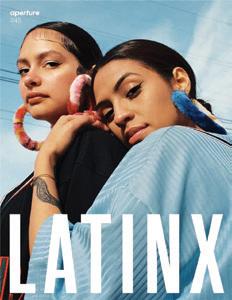
Feminist with a To-Do
List notepad
Take down the patriarchy strategically, one item at a time. 4-x-6-in. notepad, 50 pages. Goldenrod with black text. $10/Member $9

The Advantages of Being a Woman Artist Recycled Bag
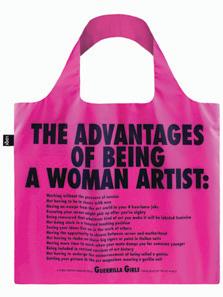
Make a statement with this recycled bag by the Guerrilla Girls, made of 100% recycled taffeta. GREEN CIRCLE® certified. 19.7 x 16.5 in. $16.50/ Member $14.85
Hilma af Klint Socks (No. 7, Adulthood)
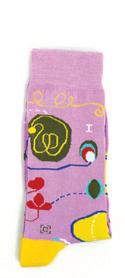

Add a pop of color to any outfit with these lilac-and-yellow Hilma af Klint socks. 80% combed cotton, 17% polyamide, 3% elastane. Made in Portugal. $15/Member $13.50
Naked Lunch Blanket
Winter is coming: this blanket will bring you summer vibes on cold days. 100% cotton woven blanket, made in the U.S.; 50 x 60 in. $160/ Member $144

Women Painting Women
This book recognizes female perspectives in portrait painting and features artists such as Emma Amos, Alice Neel, Jordan Casteel, Somaya Critchlow, and Apolonia Sokol. Hardcover, 172 pages. $49.95/ Member $44.96

Judy Chicago Scarf
(Through the Flower)
Want to wear a piece of art around your neck? This silk scarf, created in collaboration with Judy Chicago, is based on her 1973 work. 100% silk, 43 x 43 in. $138/Member $124.20

Womankind World Domination Action Planner

The notebook every woman needs in her life. 128 pages, comes in dotted and ruled, 9.75 x 7.75 in. $22/Member $19.80
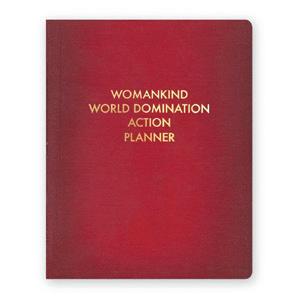
WOMEN IN THE ARTS
25
Shop NMWA online at https://shop.nmwa.org
1250 New York Avenue NW Washington, DC 20005-3970
// DON'T MISS
Join Us!
During our top-to-bottom renovation, plan a visit to see outdoor art installations at the museum; attend online programs that bring the museum to you at home; and learn about how to support our ambitious building project.
Lookout
NMWA’s Lookout project presents command ing public art installations on the exterior of the museum. Work by MISS CHELOVE has been extended though September 26, and a new installation by Katharina Cibulka will be unveiled on October 28.
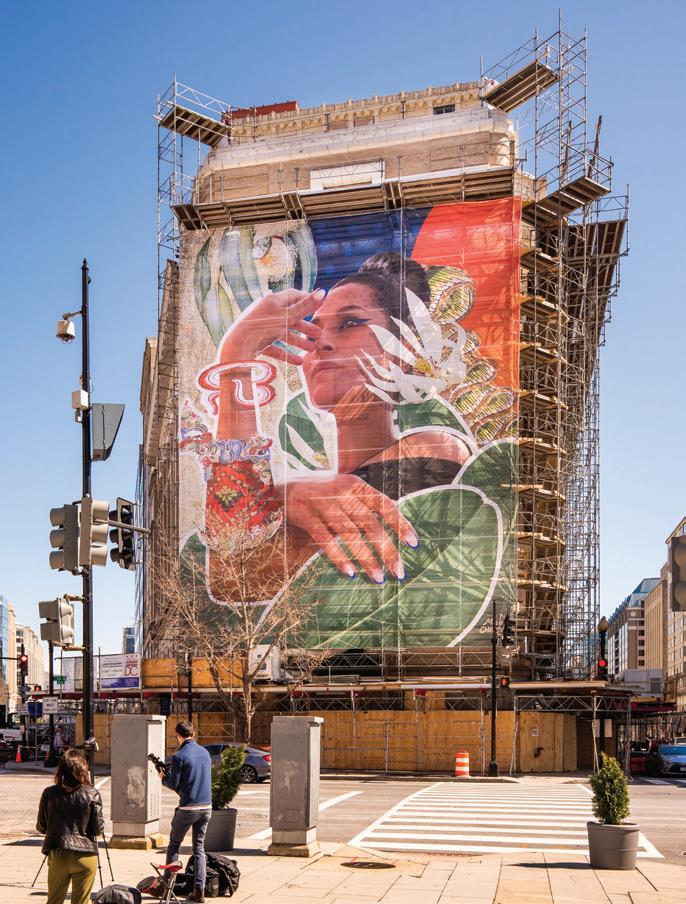
Space to Soar
As we prepare to reopen NMWA’s landmark building in fall 2023, we value your support more than ever! To learn more about our extensive renovation and support our Space to Soar capital campaign, see p. 20 or email aclexton@nmwa.org
MISS CHELOVE, Reseeded: A Forest Floor Flow (installation view), 2022; Printed mesh, 60 x 48 ft.; Commissioned by the National Museum of Women in the Arts with support provided by the DC Commission on the Arts and Humanities
© 2022 MISS CHELOVE; PHOTO BY KEVIN ALLEN




















































